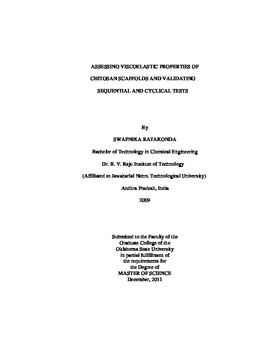| dc.contributor.advisor | Madihally, Sundar V. | |
| dc.contributor.author | Ratakonda, Swapnika | |
| dc.date.accessioned | 2014-04-16T03:07:37Z | |
| dc.date.available | 2014-04-16T03:07:37Z | |
| dc.date.issued | 2011-12-01 | |
| dc.identifier.uri | https://hdl.handle.net/11244/9661 | |
| dc.description.abstract | We evaluated and modeled the viscoelastic characteristics of chitosan and chitosan gelatin scaffolds prepared using a freeze-drying technique. Chitosan and chitosan-gelatin solutions (0.5 wt% and 2 wt%) were frozen at -80�C and freeze dried. Using the scaffolds, uniaxial tensile properties were evaluated under physiological conditions (hydrated in Phosphate Buffered Saline at 37C) at a crosshead speed of 0.17 mm/s. From the break strain, limit of strain per ramp was calculated to be 5% and the samples were stretched at a strain rate of 2.5 %/s. Ramp and hold type of stress relaxation tests were performed for five successive stages. Chitosan and chitosan-gelatin showed nearly 90% relaxation of stress after each stage. The relaxation behavior was independent of the concentration of chitosan and gelatin. Also, changes in the microstructure of the tested samples were evaluated using an inverted microscope. The micrographs acquired after relaxation experiments showed orientation of pores suggesting the retention of the stretched state even after many hours of relaxation. Based on these observations, a model containing i) a hyper-elastic spring (containing two parameters) and ii) retain pseudo components (containing three parameters) were developed in Visual Basic Applications accessed through MS Excel. The models were used to fit the experimental stress-relaxation data and the parameters obtained from modeling were used to predict their respective cyclic behaviors, which were compared with cyclical experimental results. These results showed the model could be used to predict the cyclical behavior under the tested strain rates. The model predictions were also tested using cyclic properties at a lower strain rate of 0.0867%/s (5%/min) for 0.5 wt% scaffolds but the model could not predict cyclical behavior at a very slow rate. In summary, this approach can be followed to select the best pseudo-component model that can be used to model sequential strain-and-hold stage and predict cyclical properties for the same strain rate of a particular scaffold. | |
| dc.format | application/pdf | |
| dc.language | en_US | |
| dc.publisher | Oklahoma State University | |
| dc.rights | Copyright is held by the author who has granted the Oklahoma State University Library the non-exclusive right to share this material in its institutional repository. Contact Digital Library Services at lib-dls@okstate.edu or 405-744-9161 for the permission policy on the use, reproduction or distribution of this material. | |
| dc.title | Assessing Viscoelastic Properties of Chitosan Scaffolds and Validating Sequential and Cyclical Tests | |
| dc.type | text | |
| dc.contributor.committeeMember | Rhinehart, Russell R. | |
| dc.contributor.committeeMember | Ramsey, Joshua D. | |
| osu.filename | Ratakonda_okstate_0664M_11824.pdf | |
| osu.college | Engineering, Architecture, and Technology | |
| osu.accesstype | Open Access | |
| dc.description.department | School of Chemical Engineering | |
| dc.type.genre | Thesis | |
| dc.subject.keywords | chitosan | |
| dc.subject.keywords | cyclical behavior | |
| dc.subject.keywords | psuedo-component model | |
| dc.subject.keywords | scaffolds | |
| dc.subject.keywords | stress-relaxation behavior | |
| dc.subject.keywords | viscoelasticity | |
